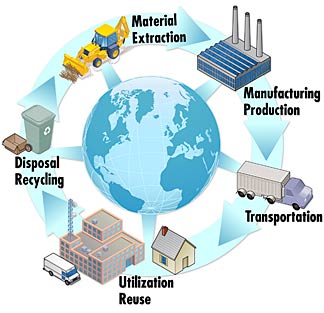
As indicated in the first article of this series, the impact on the environment must be considered when making decisions about what energy resources should be pursued to obtain abundant, affordable, and reliable electricity. The true environmental impact of generating electricity from an energy resource can only be realized by considering the resource’s entire lifecycle, not just the electricity-generating phase of the lifecycle. This discussion will focus on understanding the lifecycle of an energy resource. The actual environmental impact of transitioning to solar and wind resources for power generation and transportation will be addressed in the next article in this series.
The Energy Resource Lifecycle
This lifecycle includes the manufacturing of machines and devices needed to convert the resource to electricity, transmitting the electricity to the grid, and dispositioning of all lifecycle wastes. The graphic below is a simple, but useful, visual aid for understanding the energy resource lifecycle.

Let’s look at some details of this lifecycle that rarely get addressed in energy discussions, especially with respect to the marketing of “renewable” energy resources. Solar and wind energy are generally touted as both “free and clean,” a claim that is true only with regard to their initial states — that is, as photons and kinetic energy of air molecules, respectively. They cease to be free and clean when these resources are converted to any other form of energy.
The utilization of energy resources for generating electricity necessarily requires the mining of raw materials for
- construction of structures to facilitate
- raw material processing operations
- production of processing materials (e.g., chemicals)
- production of building construction materials
- production of energy conversion machines and devices
- production of transportation equipment
- the conversion of energy resources into electricity
- dispositioning of waste products
- manufacturing of
- machines for mining of raw materials
- equipment and materials (e.g., chemicals) for processing raw materials
- equipment and materials for producing building construction materials
- equipment and materials for producing energy conversion machines and devices
- equipment for transporting materials, machines, and devices between lifecycle locations
- equipment and materials for dispositioning of processing wastes, construction wastes, operational wastes, and devices that have reached end-of-life status
- obtaining usable energy resources (i.e., fossil fuels and uranium)
Raw materials must be mined and transported to refining facilities for processing to obtain useful building and manufacturing materials.
Processed material resources are required for the construction of facilities that refine raw materials and manufacture the machines, devices, and equipment for energy conversion and electricity transmission. Processed material resources are also required for manufacturing the machines, devices and equipment within these facilities.
Materials and products must be transported from where they originate to where they are needed.
Energy resource utilization facilities operate the energy conversion machinery and devices that convert energy resources to electricity and transmit it to the grid. Ideally, waste disposal/recycling facilities and operations recover, process, and store harmful waste produced in all phases of the energy resource lifecycle.
Much of the material in renewable energy devices cannot be recycled when the devices reach the end of their life, as noted by Mark Mills and Alexander Ackley in their 2019 article in The International Chronicles, “The Destructive Myth of Green Energy: If You Want ‘Renewable Energy’ Get Ready to Destroy the Environment.”
Unfortunately, the technologies for disposing of some materials from photovoltaic panels and wind turbines that have reached end-of-life have yet to be developed. Scientists at America’s National Renewable Energy Laboratory in Lakewood, Colorado, have warned that in the next few decades, the world faces a tidal wave of used, non-recyclable turbine blades that will number hundreds of thousands, if not more. And most renewable energy lifecycle waste material cannot be recycled either.
Battery Energy Storage Systems
As stated in an earlier article in this series, battery energy storage systems have been proposed to compensate for the intermittency of solar- and wind-generated electricity in a 100-percent renewables scenario. Therefore, the true environmental impact of generating electricity from only solar and wind resources must also include in the resource lifecycles all of the materials that must be mined and manufactured to fabricate batteries, to dispose of wastes from battery production, and to dispose of of batteries at the end of their useful life. Currently, there is no market for recycling industrial batteries.
The actual costs, both financial and environmental, of utilizing any energy resource for generating electricity cannot be obtained without taking into account every phase of the resource lifecycle.
Other articles in this series:
Back to Energy’s Future? — Part 1
Back to Energy’s Future? — Part 2
Back to Energy’s Future? — Part 3
Back to Energy’s Future? — Part 5
Back to Energy’s Future? — Part 6
Back to Energy’s Future? — Part 7



